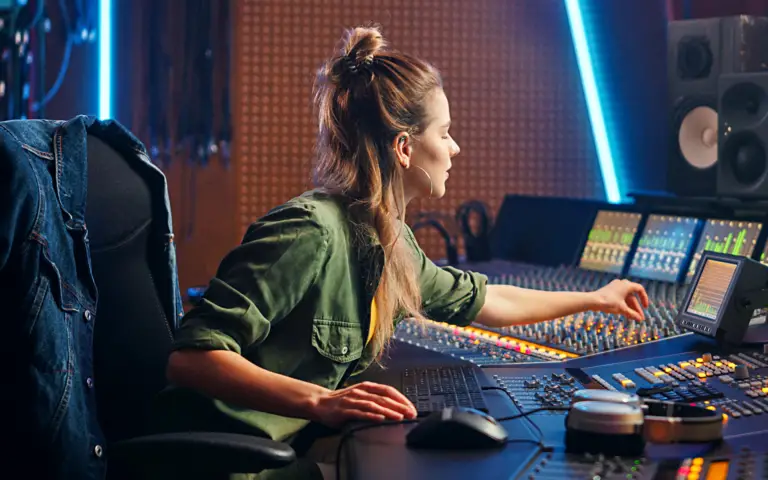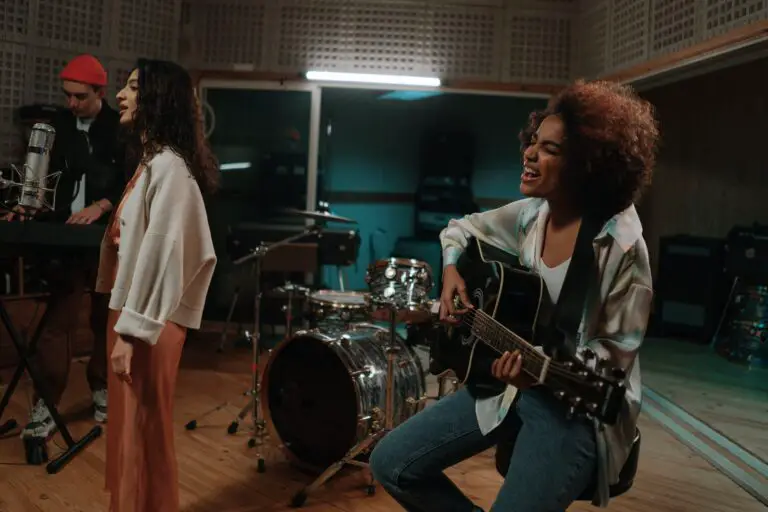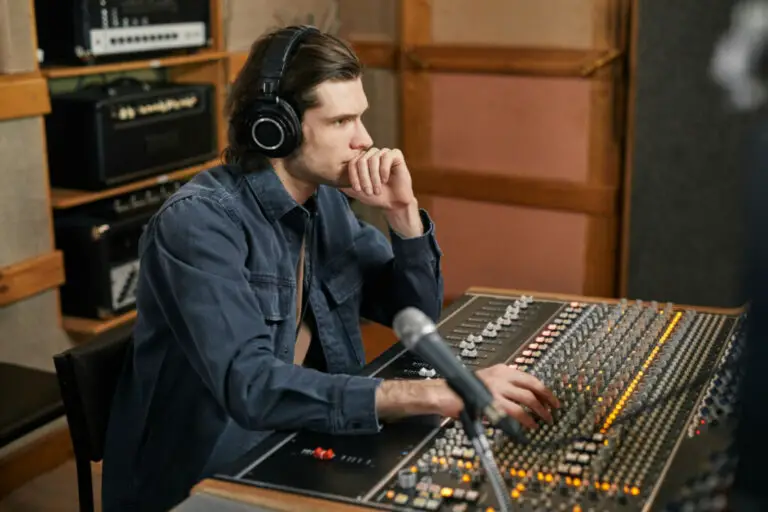Why Does My Mic Sound Muffled? How To Fix It
To fix a microphone, you need to troubleshoot to pinpoint the exact cause of the issue. A muffled sound is one of those potential issues. So, why does your microphone sound muffled, and how can you fix it?
A microphone can sound muffled if it is in a bad position to catch sounds. Adjust the position of the microphone to fix the issue. The microphone will also sound muffled if it has hardware or recording issues or the wrong microphone is used.
It can be challenging to figure out what is causing your microphone to sound muffled and how to fix it. The following information has been compiled below to help you pinpoint the reason your microphone sounds muffled and to provide you with ways you can fix it.
Reasons Why Your Microphone Sounds Muffled

There are a few different reasons why your microphone sounds muffled. Before you fix the issue, you must determine why the muffled sound is occurring. If you can’t identify the exact cause, finding out how to fix your microphone can be challenging. Below is a list of some of the more common reasons.
1. Microphone (or face) placement
The most common reason a microphone sounds muffled is related to microphone placement. You won’t sound right if you are not close to the microphone. This is typically an issue that can be fixed in a matter of minutes. It might be another issue if it still sounds off after repositioning your face.
2. You aren’t speaking directly into your mic
Your microphone can also sound muffled if you are not speaking directly into it. You must speak directly into the microphone for a clear and crisp recording. This issue is often caused by looking down or up at a script or music. So, be aware of what things might reposition where you are speaking.
3. Hardware issues
Sometimes, a hardware issue causes your microphone to sound muffled. Fixing your microphone will likely take a while if it has a hardware issue. If there is something wrong with the hardware, there is a chance that you will need to take your microphone to a tech store so they can find the issue and fix it for you.
4. Software issues
Many different kinds of software can be used for recording. If the quality of your recording sounds muffled, you may be using the wrong recording software. There also could have been some technical issue with the recording software that made your recording sound muffled.
There are a lot of different brands of microphones, but some are picky about the software they are compatible with. Sometimes, your microphone might not work well with your recording software or device. This can result in the recording sounding muffled or of low quality.
5. Old microphone
Depending on your microphone, a muffled sound can mean it is time to get a new microphone. Cheap microphones often don’t last as long as more expensive microphones. Some inexpensive microphones will sound muffled even if you use the right software and speak directly into it.
How to Fix Issues With Your Microphone

There are many things you can do to fix a muffled microphone. Below, you’ll find a list of suggested fixes you can make):
1. Reposition your microphone (and your face)
For some microphone issues, you can fix the muffled sound by repositioning the microphone. When you first notice your microphone produces muffled recordings, Troubleshoot by moving the microphone. This is enough to fix any recording issues you may be experiencing.
After you readjust your microphone, change how you are speaking into the microphone. Make sure you talk directly into the microphone.
You’ll want to run tests at multiple volume levels. For example, if you need to get loud, get loud from various positions. Test how those positions affect the audio quality
2. Check the cables
Ensure the cords and cables connected to your microphone are plugged in correctly and aren’t broken or kinked. If the cords or cables seem broken, replace them.
Check for frayed chunks or abnormal bends. Sometimes, there are no physical signs of cord-related distress. Test other cables (if you have them).
3. Use another recording software
If your microphone still sounds muffled, try using a recording software you don’t usually use. Make sure that it’s compatible with your microphone. If the company that makes your microphone recommends using specific recording software programs, try them out.
If you don’t know of any recommended recording software programs, find a free program and use it to test your microphone.
4. Repair or replace the microphone
If none of the previously mentioned solutions fix the muffled sound of your microphone, there could be an issue with the hardware of your microphone. This is an issue that most people can’t fix, so you’ll either need to bring it to a repair shop or buy a new microphone.
Microphone repair by a professional can cost a lot of money. If you have a high-quality microphone that is relatively new, it may be worth it for you to do so. You may not have to pay for it if the microphone is still under warranty.
It may be worth replacing if you have an old, cheap microphone. Repairs on more affordable microphones are often not worth the cost.
Tips for Improving The Audio Quality On Your Microphone

1. Account for background noise
When recording audio, consider the noise in the background. Background noise can impact the quality of your recordings.
Before recording, turn off any other noise-making devices, such as a television, radio, or fan. This will allow you to have clean and crisp audio when recording.
If you’re a parent, it can be highly beneficial to record when your kids are napping, sleeping, or occupied in a different room. This allows you to record without worrying about the sounds of small children being heard in the background of your audio.
2. Record with plenty of time
Another thing to consider before recording is the time you have to record. If you have only a short amount of time, your audio might sound rushed or hurried.
It would be best to leave yourself enough time to take your time when recording. If you feel rushed, you won’t be able to focus on quality.
Alternatively, suppose you can only record a portion of whatever you’re creating. The audio quality may shift when you begin recording again, making part of the recording sound muffled.
3. Breathe properly
It would be best if you took full, deep breaths when recording. Whether you are recording vocals for music or a podcast, breathing correctly can positively impact the quality of your recordings.
Breathing deeply forces you to slow down, making your audio seem well-paced. If your words are supported with enough breath, you won’t sound muffled, while the opposite is true if you don’t breathe often or deep enough.
4. Annunciate your words
When recording, you must annunciate your words. This allows your voice to sound crisp and clear. For some, talking as they usually do while recording can make it sound like they are mumbling. If you mumble, the recording might sound muffled, making it seem wrong with your microphone.
5. Don’t get nervous
If you get scared easily, record by yourself if possible. You might start to mumble or shift to show nervousness. This might no longer speak directly into the microphone, making the recording muffled.
You might get nervous thinking about speaking to an audience. If you are starting a YouTube channel, this isn’t uncommon.
So, think about how you conquer fear in other ways. Either explore the idea, go through deep breathing exercises, or ask yourself the worst that could happen. Know that whatever “bad” could happen is a learning experience.
6. Know your microphone’s features
Before you begin recording regularly, you must know how your microphone works.
Certain microphones need you to annunciate more than others. Other microphones can pick up noise in the background more than others.
Other microphones (those that have dials on them) have different recording settings. Knowing those settings lets, you understand what works for your unique recording situation.
Recommended Microphones With High Audio Quality

If you have tried everything and took your microphone to be repaired by a professional, but your microphone still produces muffled sound, you will likely need to purchase a new one.
The microphone that will work best for you will vary depending on your situation and what you’re recording. The best microphone for recording musical vocals will differ from the best for recording instruments or your speaking voice.
It is vital that when you decide to purchase a new microphone, you choose the one that will work best for what you want to record.
Audio-Technica AT2035 – great for vocals
- DELIVERS SMOOTH, DETAILED AUDIO – The versatile Audio Technica AT2035 Microphone has a large diaphragm that produces pleasant, natural sound and 12dB low noise.
- OFFERS IMPROVED NOISE ISOLATION – The cardioid polar pattern of the microphone reduces the sound pickup from the rear and sides. You can freely record crystal-clear vocals or instruments.
- HANDLES HIGH SOUND PRESSURE LEVELS WITH EASE – The selectable 10dB attenuation pad enables the mic to handle high SPL signals up to 158dB without overloading.
- REDUCES UNWANTED RUMBLES – The switchable 80Hz high-pass filter minimizes the undesirable ambient room noise such as the low rumble of an air conditioning system or floor vibration.
- INCLUDES – Audio Technica AT2035 Cardioid Condenser Microphone Perfect for Studio, Podcasting & Streaming, XLR Output, Includes Custom Shock Mount and 5/8″-27 to 3/8″-16 Threaded Adapter. Protective Pouch. Blucoil All-in-One Microphone Boom Arm Plus Pop Filter. 2-Pack of Blucoil 10-Foot Balanced XLR Cables – Premium Series 3-Pin Cable for Microphones, Speakers and Pro Devices (Male-to-Female).
Audio-Technica AT2035 is excellent for vocals when recording your music. This microphone can pick up the subtleties of your voice because it is a large diaphragm condenser microphone.
When using this microphone in your home, it may pick up any noise in the background, so you must try to reduce the noise surrounding you while recording. Taking this precaution will allow your recording to have better quality. In addition to recording vocals for music, this microphone has been used by many individuals who record YouTube videos or podcasts.
Blue Yeti Condenser Microphone
- Custom three-capsule array: This professional USB mic produces clear, powerful, broadcast-quality sound for YouTube videos, Twitch game streaming, podcasting, Zoom meetings, music recording and more
- Blue VOICE software: Elevate your streamings and recordings with clear broadcast vocal sound and entertain your audience with enhanced effects, advanced modulation and HD audio samples
- Four pickup patterns: Flexible cardioid, omni, bidirectional, and stereo pickup patterns allow you to record in ways that would normally require multiple mics, for vocals, instruments and podcasts
- Onboard audio controls: Headphone volume, pattern selection, instant mute, and mic gain put you in charge of every level of the audio recording and streaming process
- Positionable design: Pivot the mic in relation to the sound source to optimize your sound quality thanks to the adjustable desktop stand and track your voice in real time with no-latency monitoring
For some, using a Blue Yeti condenser microphone can be highly beneficial when recording. This microphone is exceptionally sturdy and lasts for many years, so you won’t have to replace your microphone very often. Setting this microphone up and connecting it to multiple devices is easy.
Lauten Audio LA-220
- Large-Diaphragm FET Condenser Microphone with Cardioid Polar Pattern
- 120Hz Highpass 12kHz Lowpass Filters
- 1″ Pressure Gradient Capsule
- Transfmer-Balanced Output
A Lauten Audio LA-220 can be used to record quality vocals, and if you purchase it, you won’t have to spend a small fortune. This microphone can be easily purchased online, which is excellent for people who do not want to visit a tech store to buy a high-quality microphone.
Shure SM7B
- ONE MICROPHONE FOR EVERYTHING – Studio Recording, Home Recording, Podcasting & Streaming. The SM7B Is Trusted By The Worlds Leading Vocalists, Podcasters & Streamers.
- STUDIO VOCAL RECORDING – The SM7B’s Dynamic Cartridge With Smooth, Flat, Wide-range Frequency Response Produces Exceptionally Clean & Natural Reproduction Of Both Music & Speech.
- PODCAST & BROADCAST – Found In The Top Podcasting Studios Around The World, The SM7B Air Suspension Shock Isolation & Pop Filter Eliminate Both Mechanical Noise And Breathiness. So Words Get Through And The Rest Stays Out Of The Mix.
- STREAMING CONTENT – Professional Live Streaming Starts With A Microphone Capable Of Capturing Exceptionally Clean And Natural Reproduction Of Both Music And Speech. The SM7B Has Been A Pioneer In Such Abilities For Decades.
- PROFESSIONAL XLR CONNECTION – The XLR Connection Along With An Audio Interface Allows You More Control Over The Sound — Thus A Better Overall Sound Quality.
The Shure SM7B is an excellent microphone for recording podcast episodes or audio for a YouTube video. Many other microphones are compatible with this microphone, making it a great option if you will be recording with multiple people. This microphone is also very budget-friendly for most people.
Wrap Up
Overall, there are many things that you can do to fix a microphone that makes sounds seem muffled. However, if nothing you do fixes the issue and your microphone can’t be repaired, you must replace it if you want to create high-quality recordings. However, don’t replace your microphone until you have done everything possible to fix it, as most high-quality microphones are expensive.













